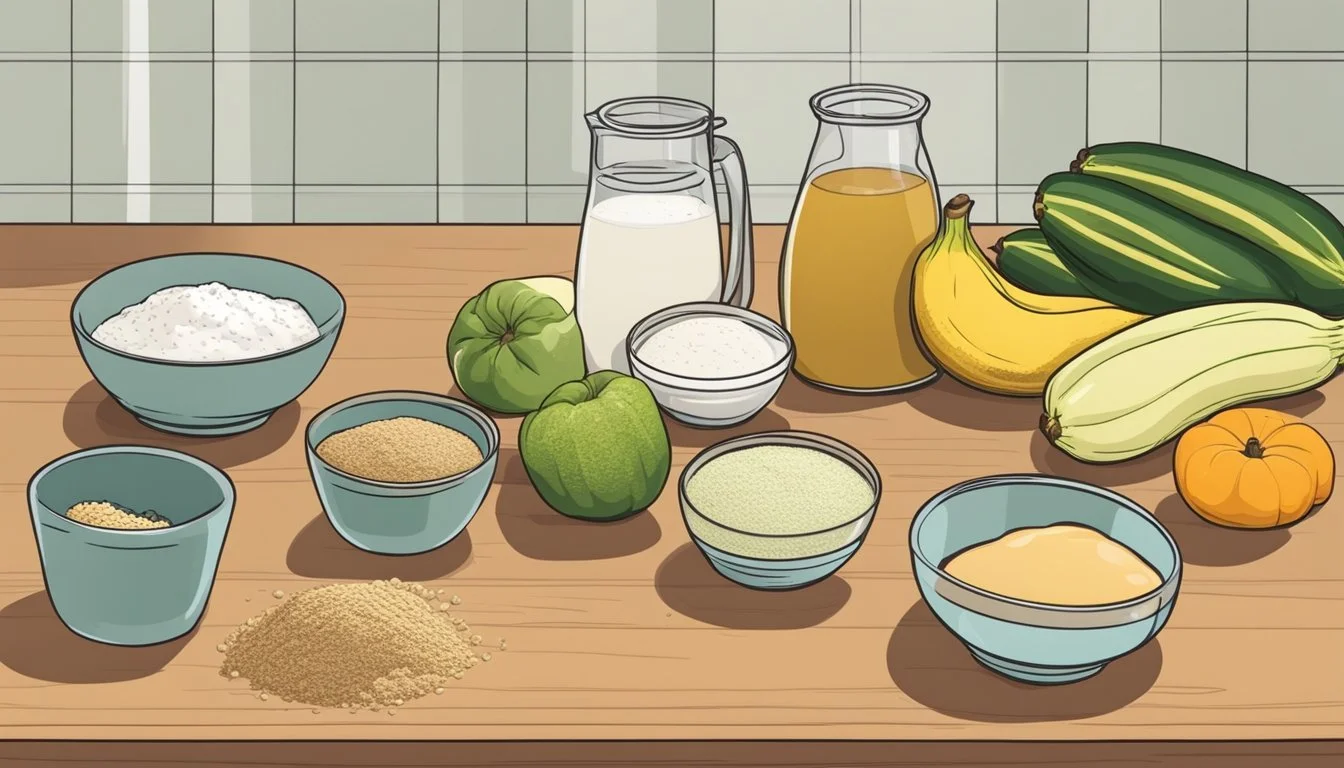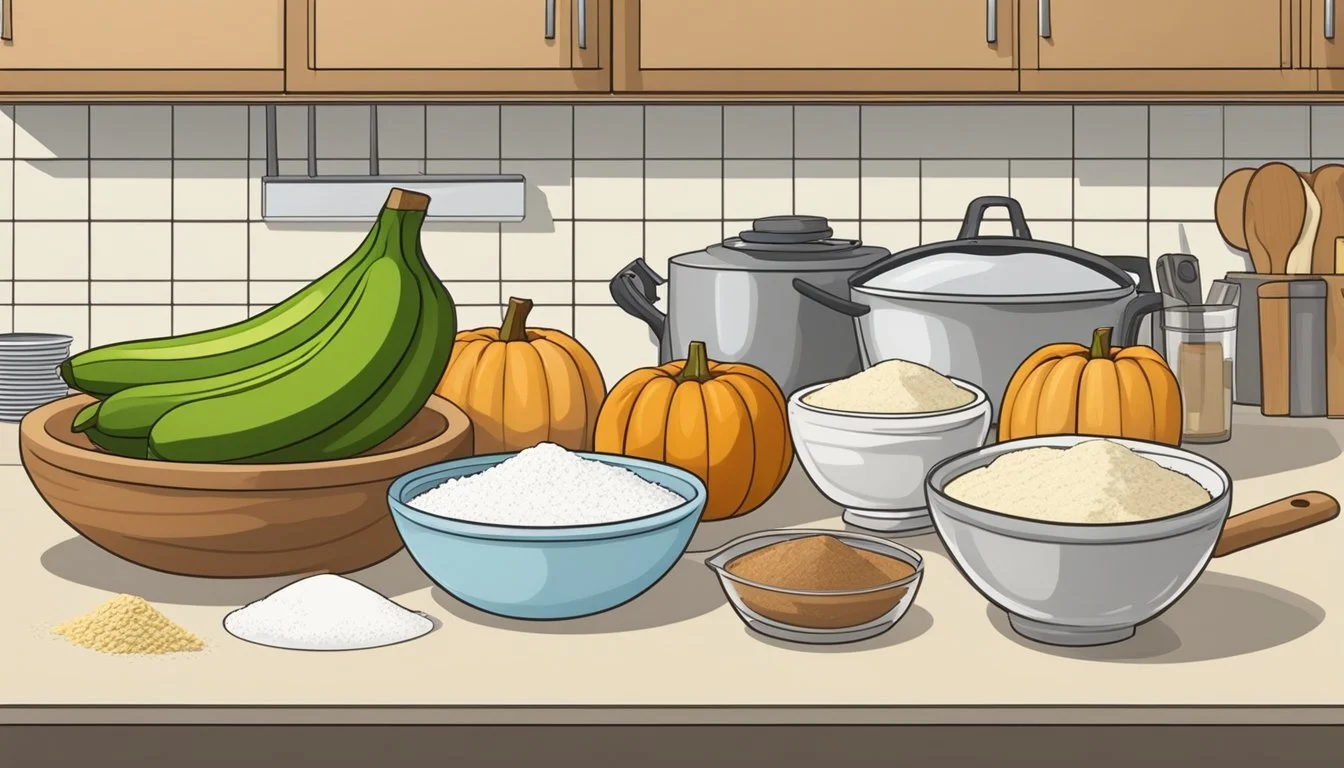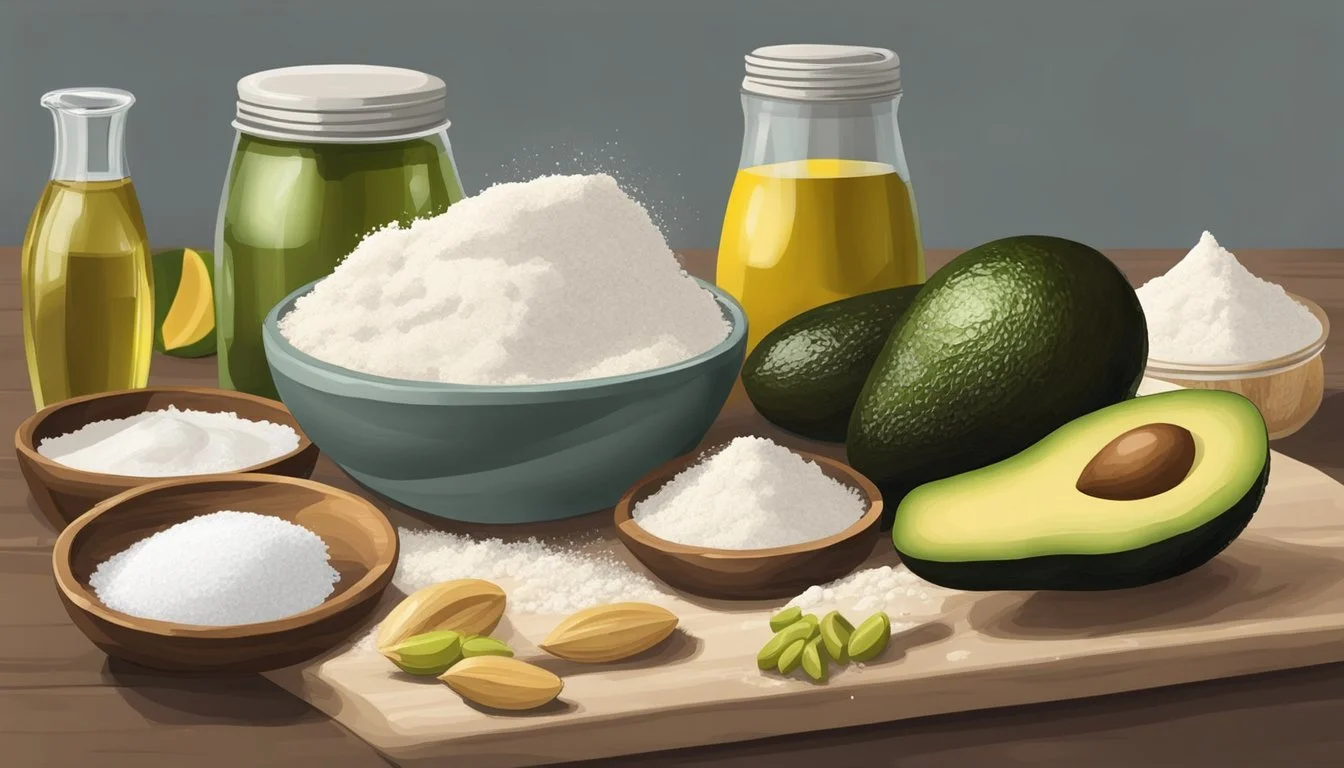Banana Bread Substitutes
Top Alternative Ingredients for Your Recipe
Banana bread is a beloved classic, treasured for its moist texture and sweet flavor, often punctuated by the distinctive taste of ripe bananas. The fruit not only provides the characteristic flavor but also contributes to the bread's moisture and structure. However, there are situations when bananas aren't available, are too costly, or perhaps a dietary restriction prevents someone from enjoying them. In these instances, finding a suitable substitute is essential to recreate the qualities that bananas naturally impart to the bread.
Fortunately, there is a wealth of alternative ingredients that can mimic the properties of bananas in baking. Options such as pumpkin puree and avocados can be used to achieve a similar consistency and moisture. While pumpkin puree offers a different, yet complementary flavor profile, avocados provide a buttery texture without overpowering the classic taste of the bread. Additionally, avocado is an excellent choice for maintaining the desired creaminess in other banana-based recipes, like smoothies or puddings.
Other substitutes like pureed beans or coconut cream can also fill the void left by bananas. These alternatives not only replicate the desired thickness and moisture but may also add an interesting new dimension to the flavor. Coconut cream, for instance, can impart a tropical hint, while pureed beans, an unconventional choice, offer a subtle nutty undertone. These substitutes allow for creativity and can cater to various dietary preferences or restrictions, ensuring that the joy of banana bread can be experienced by all, even without its namesake ingredient.
Understanding Banana Bread Essentials
Banana bread is a popular treat celebrated for its moist texture and rich flavor. At the heart of this beloved bake are bananas, which contribute not only flavor but also moisture and structure to the final product.
Role of Bananas
Bananas are the key ingredient in banana bread. They provide the signature sweet flavor and help to naturally sweeten the bread. Beyond taste, bananas bring moisture to the batter, a crucial element for the bread's tender crumb.
Importance of Moisture
Moisture is paramount in creating delicious banana bread; it ensures that the bread is soft rather than dry and crumbly. Ingredients that contribute moisture include bananas, but in their absence, substitutes must maintain a similar moisture level. Moist ingredients often incorporated are:
Pumpkin puree
Avocado
Silken tofu
Sweet potato puree
Each substitute adds moisture while also affecting the banana bread's taste profile.
Texture and Consistency Factors
The texture and consistency of banana bread are influenced by the choice of ingredients. Bananas naturally give the bread a dense and moist texture. When using substitutes, maintaining the consistency can be achieved by observing the right ratios. For example:
Replace mashed bananas with an equal amount of avocado for smoothness.
Use ¼ cup of ground oats to replace a ½ cup of mashed bananas for structure.
For each alternative ingredient, one must consider how it will influence the overall texture—whether it will make the bread denser or lighter, and how it can affect the bread's rise and crumb.
Common Substitutes for Bananas
When seeking alternatives to bananas in recipes, it's important to consider how the substitute will affect the texture and flavor of the final product. Here are some common replacements that maintain the necessary moisture and binding characteristics needed for baking.
Fruit Alternatives
Applesauce: It provides a similar texture and natural sweetness to banana and can be used in a 1:1 ratio.
Pumpkin Puree: This substitute adds moisture and a mild flavor, making it ideal for baking. Stir it directly into the batter as you would with bananas.
Vegetable Options
Avocado: For a buttery texture, use mashed avocados. Their creaminess closely mimics that of bananas and should also be used in equal measure to the banana quantity required in your recipe.
Sweet Potato: Mashed sweet potatoes offer a subtly sweet and creamy texture, enhancing the moisture in your baked goods much like bananas.
Egg Substitutes in Banana Bread
When baking banana bread without eggs, one has various substitutes that can provide moisture and act as binders. The following alternatives can be used to mimic the properties that eggs typically contribute to the baking process.
Plant-Based Egg Alternatives
Flax Egg: A popular choice for vegans, a flax egg is made by mixing 1 tablespoon of ground flaxseeds with 3 tablespoons of water. Once it rests for a few minutes, it thickens and can replace one egg. It not only binds ingredients but also adds a nutty flavor.
Chia Seeds: Similar to flax, chia seeds can be used to create a gel-like substitute. Mix 1 tablespoon of chia seeds with 2.5 tablespoons of water and let it sit for a few minutes to thicken. This quantity is equivalent to one egg.
Silken Tofu: Pureed silken tofu is an effective binder. Use 1/4 cup of pureed tofu to replace one egg. It makes the bread denser and adds protein.
Agar-Agar: This plant-based gelatin can replace eggs as a binder. Dissolve 1 tablespoon of agar-agar in 1 tablespoon of water for each egg to be replaced.
Dairy and Non-dairy Binders
Yogurt: A 1/4 cup of unsweetened yogurt can substitute for an egg. It brings moisture and a slight tanginess, contributing to a tender crumb in banana bread.
Gelatin: For those not following a vegetarian or vegan diet, gelatin can act as a binding agent. Use 1 tablespoon of gelatin dissolved in 1 tablespoon of water to replace one egg. This will help hold the ingredients together and add structure to the bread.
Sweetness Adjustments and Sugar Alternatives
When creating sugar-free banana bread, the choice of sweetener is crucial to maintain the desired taste and texture. Here are some popular alternatives to traditional sugar.
Natural Sweeteners
Honey: A robust substitute for sugar, honey can be used in a 1:1 ratio but is sweeter, so one may consider using less. It adds moisture and a distinct flavor that complements banana bread well.
Pros: Adds moisture, rich flavor
Cons: Higher in calories, may require recipe adjustment for less liquid
Maple Syrup: Known for its rich, deep flavor and liquid form, maple syrup can be swapped in the same amounts as sugar. However, additional adjustments for its liquid state may be necessary.
Pros: Unique flavor profile, natural product
Cons: May make batter more liquid, affecting bread texture
Agave Nectar: It's sweeter than sugar, so less is required. Agave nectar also has a lower glycemic index, which means it won't spike blood sugar levels as rapidly.
Pros: Low glycemic index, usable in lower quantities
Cons: Can be expensive, careful balancing required to maintain consistency
Molasses: Adds a rich, caramel-like flavor along with moisture. Because it's potent, a smaller quantity is enough compared to sugar.
Pros: Nutrient-rich, strong flavor
Cons: Distinct taste might not suit all palettes, affects bread color
Reduced-Calorie Sweeteners
Sweetened Condensed Milk: This can impart sweetness and moisture, albeit with added calories. It should be used sparingly, due to its richness and sugar content.
Pros: Adds creaminess and richness, readily available
Cons: High in calories, contains sugar and lactose
When using any alternative sweetener, it's important to take into account not just the sweetness level, but also how the product will affect the moisture and overall structure of the banana bread. Each substitute has its unique properties that need to be considered in recipe adjustments.
Flour and Leavening Adjustments
When making banana bread, the variety of flour and proper use of leavening agents can significantly affect the texture and rise of the final product. Specific adjustments ensure the bread's optimal consistency and flavor.
Alternative Flours
For those who do not have self-raising flour or prefer a different option, all-purpose flour is a frequently used staple. One can substitute all-purpose flour with oat flour on a one-to-one basis for a more wholesome alternative.
It is important to note that oat flour may absorb more moisture, so additional liquid might be necessary to achieve the desired batter consistency.
Leavening Agent Variations
Typically, banana bread recipes call for certain leavening agents that contribute to the bread's rise and texture. When not using self-raising flour, adjustments need to be made:
Baking Powder: For every cup of all-purpose flour, add 1 teaspoon of baking powder to enable the bread to rise.
Baking Soda: If the recipe includes acidic ingredients like yogurt or buttermilk, adding 1/4 teaspoon of baking soda per cup of flour can help with leavening.
Yeast is not commonly used in traditional banana bread recipes due to its longer fermentation time and the flavor it can impart.
To maintain consistency in your banana bread, ensure precise measurements of these leavening agents, avoiding the temptation to add in excess which could lead to an undesirable texture and taste.
Incorporating Fats and Oils
In the pursuit of creating the perfect banana bread, the types of fats and oils used can significantly impact both the texture and taste of the final product. Choices range from traditional butter to a variety of oil options, each contributing its unique characteristics.
Butter and Oil Substitutes
Unsalted Butter: Traditionally used in banana bread for its creamy texture and rich flavor, unsalted butter is often substituted to control the overall salt content in the recipe.
For those looking to replace butter:
Coconut Oil: A popular vegan substitute, coconut oil can be used in a 1:1 ratio for unsalted butter, lending a subtle coconut flavor.
Avocado: Mashed avocado serves as a nutrient-dense substitute, providing healthy fats while maintaining moisture; use equal parts to replace butter.
Bold Choice: For an indulgent twist, consider substituting with equal parts of coconut cream, which offers a luxurious texture.
Healthier Fat Alternatives
In keeping with healthier variations of banana bread, certain alternatives to traditional fats can enhance nutritional value without compromising on taste or texture.
Greek Yogurt: Incorporating Greek yogurt in place of part or all of the fat requirement can reduce overall calorie count while still achieving a moist crumb.
Unsweetened Applesauce: Another healthier option, it can substitute oil in a 1:1 ratio and also adds natural sweetness, potentially reducing the need for added sugars.
Consideration: While they are not a direct substitute for fats, coconut milk can be used to adjust the bread's consistency, especially when using denser fat substitutes like avocado.
In their quest for a healthier banana bread, bakers can explore various fat alternatives to tailor the recipe to their dietary preferences, ensuring the result is both satisfying and aligned with their nutritional goals.
Flavor Enhancements and Spices
When revamping the classic banana bread, spices play a crucial role in elevating flavor, while thoughtful additions can create unique taste profiles that tantalize the palate.
Common Spice Add-ins
Commonly incorporated spices such as cinnamon, nutmeg, and ginger are essential in enhancing the depth and warmth of banana bread. They complement the sweetness and can be adjusted according to personal preference.
Cinnamon: Adds a sweet and woody flavor, often used in a half to one teaspoon measurement.
Nutmeg: Delivers a spicy and bitter note, best used in small quantities, such as a quarter teaspoon.
Ginger: Provides a sharp and peppery zing, typically used in a finely ground form in a similar quantity to nutmeg.
The use of vanilla extract is also widespread, contributing a subtle floral essence that can carry and harmonize the flavors of the other spices.
Unique Flavor Combinations
Banana bread enthusiasts and bakers can experiment with citrus zest, such as lemon or orange, to add a bright and refreshing contrast to the bread's richness.
Citrus Zest: Grated lemon or orange zest can be included in amounts ranging from a teaspoon to a tablespoon, depending on the desired intensity.
Incorporating nuts such as walnuts or pecans not only introduces a textural element but also a nutty undertone which complements the natural flavors of the spices.
Nuts: Chopped and folded into the batter, or sprinkled on top; suggested amount is about a half cup to maintain balance.
When pairing these enhancements with banana substitutes like applesauce or pumpkin puree, it's advisable to adjust the quantities to maintain flavor balance and avoid overpowering the delicate taste of the bread.
Healthy Additions and Nutritional Improvements
When improving banana bread to enhance its nutritional profile, one can consider integrating nuts and seeds for added benefits and incorporating superfoods to elevate its health quotient.
Nut and Seed Enrichment
Incorporating a variety of nuts like walnuts, pecans, or almonds into banana bread not only adds a textural contrast but also infuses the bread with healthy fats, protein, and fiber which are essential for maintaining satiety and heart health. Seeds such as flax seeds and chia seeds serve as excellent sources of omega-3 fatty acids and can be seamlessly embedded in the recipe without altering the bread's flavor profile. Their content of fiber and protein further enriches the bread.
Walnuts: Rich in omega-3, an essential fat not readily produced by the body
Pecans: Packed with vitamins and minerals; add a buttery flavor
Almonds: High in vitamin E, good for skin health
Flax Seeds: Offer fiber and can act as a binder when ground
Chia Seeds: Contain protein, fiber, and important minerals like magnesium
Incorporating Superfoods
The term 'superfoods' refers to ingredients with a dense concentration of nutrients, including vitamin C, folate, and antioxidants. By adding fruits such as blueberries or dark leafy greens like spinach, which are high in vitamin C and folate, the nutritional value of banana bread can be heightened. Some superfoods might even aid in reducing overall calories when used as a substitute for more traditional ingredients. For example, unsweetened applesauce can replace a portion of fat used in the bread, reducing calorie content while still maintaining moisture and enhancing fiber content.
Applesauce: Reduces fat content and adds fiber
Blueberries: Excellent source of vitamin C and antioxidants
Spinach: Loaded with folate, fiber, and a range of minerals
By strategically utilizing nuts, seeds, and superfoods, one can transform banana bread into a more nutritious treat that provides a nourishing snack or complement to a meal.
Vegan and Allergy-Friendly Options
Creating vegan and allergy-friendly banana bread is straightforward with the use of suitable substitutes for common allergens like dairy, eggs, nuts, and gluten. Here are specific options to modify recipes without compromising taste or texture.
Non-dairy Substitutes
For individuals avoiding dairy, a variety of non-dairy milks can be seamlessly integrated into banana bread recipes. These include:
Almond milk: Offers a slightly nutty flavor; avoid if allergic to nuts.
Soy milk: Provides a creamy consistency; not suitable for those with soy allergies.
Coconut milk: Adds richness; may impart a mild coconut taste.
Oat milk: Ideal for nut and soy allergy sufferers due to its neutral flavor.
When a recipe calls for buttermilk, one can combine any of these non-dairy milks with a tablespoon of vinegar to achieve the desired tanginess and leavening effect.
Gluten-Free and Nut-Free Solutions
Gluten and nut allergies require careful selection of ingredients, particularly flours. Consider these alternatives:
Oat flour: Ensures a gluten-free outcome if certified gluten-free oats are used.
Gluten-free all-purpose flour: Often a mix of rice flour, potato flour, and other gluten-free starches. Look for brands that also certify nut-free options.
Arrowroot powder: A great thickener and can be used in conjunction with gluten-free flours to improve texture.
For binding in the absence of gluten, adding xanthan gum to gluten-free all-purpose flours is a common solution. Typically, 1 1/2 teaspoon of xanthan gum per cup of gluten-free flour is sufficient. Ensure that all ingredients, including baking powder and baking soda, are certified gluten-free and nut-free when dealing with severe allergies.
Recipe Variations and Creative Ideas
Banana bread is a versatile treat that can easily be modified to cater to different tastes and dietary needs. The following subsections will explore a range of recipe variations, from the classic banana bread to adventurous themed recipes that incorporate unique flavors and ingredients.
From Classic to Cutting Edge
Traditional banana bread recipes stand the test of time with their comforting taste and moist texture. However, bakers can explore cutting-edge variations by introducing new ingredients. Whole oats are an excellent addition, bringing a heartier texture and added nutritional benefit. For a twist on texture and flavor, one can experiment with mix-ins such as chocolate chips, blueberries, or nuts.
Here are some innovative ideas to transform classic banana bread:
Chocolate Chip Banana Bread: Stir in semi-sweet chocolate chips for a delightful contrast.
Oatmeal Banana Bread: Fold in rolled oats for a chewy, nutritious spin.
Nutty Banana Bread: Add crushed walnuts or pecans for a satisfying crunch.
Bakers can also blend bananas into smoothies to repurpose the flavors of banana bread. Incorporating ingredients such as nut butter, Greek yogurt, or cinnamon emulates the taste profile in drinkable form.
Themed Banana Bread Recipes
Themes offer an organized approach to adapting banana bread recipes. Seasonal themes, like pumpkin spice in fall or lemon zest for spring, can refresh the traditional recipe. Here are a few themed banana bread recipes to inspire:
Examples of themed banana bread recipes include:
Pumpkin Banana Bread: Incorporating pumpkin puree and spices like nutmeg and cloves.
Lemon Blueberry Banana Bread: A mix of tart lemon and sweet blueberries.
To accommodate dietary preferences or restrictions, it's possible to substitute common ingredients. For instance, one can use avocado or silken tofu instead of banana to achieve a similar consistency while varying the flavor profile. Banana essence can help maintain the traditional banana bread taste even when using these substitutes.
Using the ideas from these subsections, bakers have plenty of room to experiment with banana bread and create new favorites that honor the spirit of the original while embracing new tastes and textures.







